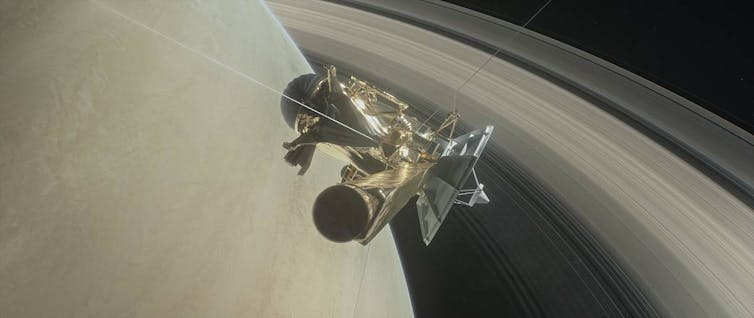The Lord of the rings – Saturn

Saturn is the sixth planet from the sun and the second–largest planet in the solar system. It is a gas giant with dozens of moons orbiting him. The planet’s most outstanding feature —the rings — can be viewed through a telescope. Jupiter, Uranus, and Neptune — also have rings, but Saturn’s are really consistent and thick.
General characteristics
The planet is made mostly of hydrogen and helium. Its core consists of metals like iron and nickel surrounded by rocky material and other compounds solidified by intense pressure and heat. Saturn is the only planet in our solar system with an average density that is less than water. The pale yellow color that we can see through photos, is due to ammonia crystals in its upper atmosphere.
Saturn’s rings are mostly structured by ice particles, some rocky debris, and dust. 83 moons are known to orbit Saturn and this number doesn’t refer to the hundreds of moonlets in its rings. His larger moon is Titan, which is also the second-largest in the Solar System.

Photo Credits: NASA/JPL
The Rings of Saturn
Small sized comets, asteroids, or shattered moons, create the gigantic rings of the planet. These moons were destroyed by Saturn’s powerful gravity. This distruction created the main raw material that later on became its rings.
They are made of billions of small chunks of ice and rock coated with other materials such as dust. Saturn’s ring system extends up to 175,000 miles (282,000 kilometers) from the planet and the vertical height is typically about 30 feet (10 meters) in the main rings.

The main structures in Saturn’s rings are:
- D, C and B rings
- Cassini Division
- A ring
- Roche Division
- F ring
- Janus/Epimetheus ring
- G ring
- Methone and Anthe ring arcs
- Pallene ring
- E ring
- Phoebe ring
Many of these have their own moonlets within. Particles travel around Saturn. While they orbit the planet, there are many collisions between them. Any particles that are in inclined orbits have a higher probability of colliding with other members, and over time they will be eliminated.
Starting at Saturn and moving outward, there is the D ring, C ring, B ring, Cassini Division, A ring, F ring, G ring, and finally, the E ring. Much farther out, there is the very faint Phoebe ring in the orbit of Saturn’s moon Phoebe.

Cassini captured this image of the moon Daphnis orbiting within the 42km Keeler Gap. The waves in the edges of the gap are caused by the moon’s gravitational pull. Credit: NASA/JPL-Caltech/Space Science Institute
Saturn’s rings are the most massive and the most diverse of the known ring systems. There are two apparent rings which are separated by what is now called the Cassini Division, measuring 2,920 miles (4,700 kilometers) in width. The main rings are A, B, and C. Rings D, E, F, and G are fainter and more recently discovered.
The latter is practically the disk with more moderate surface density. Subsequent observations from ground-based telescopes and spacecraft have revealed that these rings consist of water-ice-rich particles millimeters to meters wide.

This Cassini image from 2012 shows Titan and its host planet Saturn. Image Credit: NASA/JPL-Caltech/SSI
The Roche limit, the minimum safe distance for a moon’s orbit, is approximately 2.5 times the planet’s radius from the planet’s center.
Saturn’s giant core, spanning up to 60 percent of the planet’s width. Subtle waves in Saturn’s rings, provide scientists with numerous details about its core.
“It’s huge,” says Chris Mankovich of the California Institute of Technology, one of the authors of a new study describing Saturn’s core in the journal Nature Astronomy. “It’s definitely not something we expected to find.”

NASA’s Cassini spacecraft about to make one of its dives between Saturn and its innermost rings as part of the mission’s grand finale. NASA/JPL-Caltech
Studies of Saturn’s rings have detected waves driven by pulsation modes within the planet, offering independent seismic probes of Saturn’s interior. The observations reveal gravity-mode pulsations, which indicate that part of Saturn’s deep interior is stable against convection.
Hidden inside the solar system’s god of plenty is an unexpected bounty: Saturn’s mammoth core, spanning up to 60 percent of the planet’s width. The newly measured core, revealed through subtle waves in Saturn’s rings, appears to be ice, rock, and gas, blended into a soupy mass with blurry edges.
“It’s huge,” says Chris Mankovich of the California Institute of Technology, one of the authors of a new study describing Saturn’s core in the journal Nature Astronomy.
See here

Relationship between ice to rock mass fraction, f_ice, and predicted central heavy element mass fraction (ice plus rock), Zin.
“It’s definitely not something we expected to find. It’s just more complex than we thought was going to be the case,” says Johns Hopkins University’s Sabine Stanley.
Scientists turned to the planet’s rings, which act like a seismograph and record the gas giant’s internal sloshing and pulsing.







